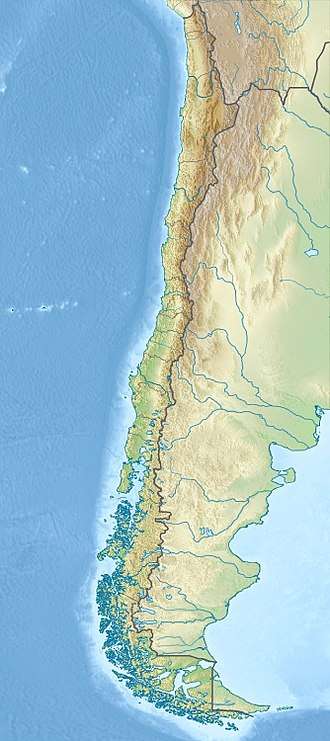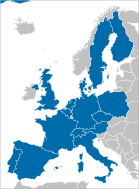Cerro Armazones Observatory
| Organization |
Ruhr University Bochum and Catholic University of the North | ||||||||||||
|---|---|---|---|---|---|---|---|---|---|---|---|---|---|
| Observatory code |
I09 | ||||||||||||
| Location | Antofagasta Region, Chile | ||||||||||||
| Coordinates | 24°35′55″S 70°12′05″W / 24.59867°S 70.20128°WCoordinates: 24°35′55″S 70°12′05″W / 24.59867°S 70.20128°W | ||||||||||||
| Altitude | 2,810 metres (9,220 ft) | ||||||||||||
| Established | 1995 | ||||||||||||
| Website | AIRUB - Observatorio Cerro Armazones | ||||||||||||
| Telescopes | |||||||||||||
| |||||||||||||
 Location of Cerro Armazones Observatory | |||||||||||||
Cerro Armazones Observatory (Spanish: Observatorio Cerro Armazones, OCA; German: Observatorium Cerro Armazones, OCA) is an astronomical observatory owned and operated jointly by the Ruhr University Bochum (RUB) and the Catholic University of the North (UCN). It was established in 1995 on the slopes of Cerro Armazones, a mountain in the Antofagasta Region of Chile.[1] The observatory is located in the Atacama Desert about 110 kilometres (68 mi) south of the city of Antofagasta. Unlike many other observatories, OCA is not located at the highest point of its host mountain. Instead, it was in a saddle approximately 340 metres (1,120 ft) below the summit and 1 kilometre (0.62 mi) to the southwest. This location has been given up due to the vicinity of the ELT construction site in January 2014. The Telescopes of the Bochum university, installed after 2006, are still fully operational, and are located 500 metres (1,600 ft) further to the west and 100 metres (330 ft) higher than the original OCA observatory, on a subsidiary peak of Cerro Armazones, Cerro Murphy. The coordinates here are those of this summit now.
On 26 April 2010, the European Southern Observatory Council selected Cerro Armazones as the site for the planned European Extremely Large Telescope.[2] The telescope will be located at the summit of the mountain at an altitude of 3,060 metres (10,040 ft). Currently the mountain top is flattened for this purpose and a new access road has been built.
Telescopes
- The 1.5-metre (59 in) Hexapod-Telescope reflector is named for its unusual mount, consisting of six high-precision struts supporting a platform to which the telescope is attached. It was developed and tested by RUB in Germany, and moved to Cerro Armazones in 2006.[3]
- A 0.84-metre (33 in) Newtonian telescope made by Halfmann Teleskoptechnik was installed by UCN in 1995.[4][5] It has been dismounted in the meanwhile due to the vicinity to the ELT construction site and is currently at ESO Paranal for refurbishing.
- The 0.81-metre (32 in) Infra Red Imaging Survey telescope is a Nasmyth reflecting telescope on an alt-azimuth mount. It was made by Halfmann Teleskoptechnik and installed in 2010.[6][7]
- A 0.41-metre (16 in) reflector made by Meade Instruments is owned by UCN.[8] It has been dismounted in the meanwhile due to the vicinity to the ELT construction site and is currently at UCN doentown in Antofagasta to be installed in a new dome near Sirius in the campus for public activities.
- The 0.25-metre (9.8 in) Berlin Exoplanet Search Telescope II (BESTII) reflector made by Takahashi Seisakusho was installed in 2007 and is owned by the DLR Institute for Planetary Research.[9][10]
- The Robotic Bochum Twin Telescope (RoBoTT - former VYSOS-6) telescopes are two 0.15-metre (5.9 in) refractors made by Takahashi Seisakusho on a common German equatorial mount.[11]
- The Bochum Monitoring Telescope (BMT) telescopes is a 0.41-metre (16 in) Newton reflector.[12]
See also
References
- ↑ "Observatorio Cerro Armazones » About Observatorio Cerro Armazones (OCA)". Universidad Católica del Norte Instituto de Astronomía. Retrieved 2015-04-24.
- ↑ "E-ELT Site Chosen". Europe: European Southern Observatory. 26 April 2010. Retrieved 26 April 2010.
- ↑ "Hexapod - Telescope". Ruhr-Universität Bochum Astronomisches Institut. Retrieved 2015-04-24.
- ↑ "Observatorio Cerro Armazones » 84-cm telescope - currently dismounted". Universidad Católica del Norte Instituto de Astronomía. Retrieved 2015-04-24.
- ↑ Barrera, S.; Luis, H. (2002). "Cerro Armazones Observatory". Observational Aspects of Pulsating B- and a Stars. 256: 285. Bibcode:2002ASPC..256..285B.
- ↑ "The Infra Red Imaging Survey (IRIS) Telescope". Ruhr-Universität Bochum Astronomisches Institut. Retrieved 2015-04-24.
- ↑ Hodapp, Klaus W.; Chini, Rolf; Reipurth, Bo; Murphy, Miguel; Lemke, Roland; Watermann, Ramon; Jacobson, Shane; Bischoff, Karsten; Chonis, Taylor; Dement, Denny; Terrien, Ryan; Bott, Kimberley; Provence, Sydney (2010). "Commissioning of the infrared imaging survey (IRIS) system". Proceedings of SPIE. 7735: 77351A. doi:10.1117/12.856288.
- ↑ "Observatorio Cerro Armazones » 41-cm telescope - currently at UCN campus in Antofagasta". Universidad Católica del Norte Instituto de Astronomía. Retrieved 2015-04-24.
- ↑ "DLR - Institut für Planetenforschung - Berlin Exoplanet Search Telescope (BEST) and BEST II". Retrieved 2015-04-24.
- ↑ Kabath, P.; Fruth, T.; Rauer, H.; Erikson, A.; Murphy, M. G.; Chini, R.; Lemke, R.; Csizmadia, Sz.; Eigmüller, P.; et al. (2009). "CHARACTERIZATION OF CoRoT TARGET FIELDS WITH BERLIN EXOPLANET SEARCH TELESCOPE. II. IDENTIFICATION OF PERIODIC VARIABLE STARS IN THE LRc2 FIELD". The Astronomical Journal. 137 (4): 3911. arXiv:0903.0325. Bibcode:2009AJ....137.3911K. doi:10.1088/0004-6256/137/4/3911.
- ↑ "RoBoTT - Robotic Bochum TWin Telescope". Ruhr-Universität Bochum Astronomisches Institut. Retrieved 2015-04-24.
- ↑ "The 40 cm Monitoring Telescope of the Universitätssternwarte Bochum, Ramolla et al., Astronomische Nachrichten, 334, 1115 (2013)". Retrieved 2015-04-24.
External links
- Astronomisches Institut at Ruhr-Universität Bochum
- Instituto de Astronomía at Universidad Católica del Norte
